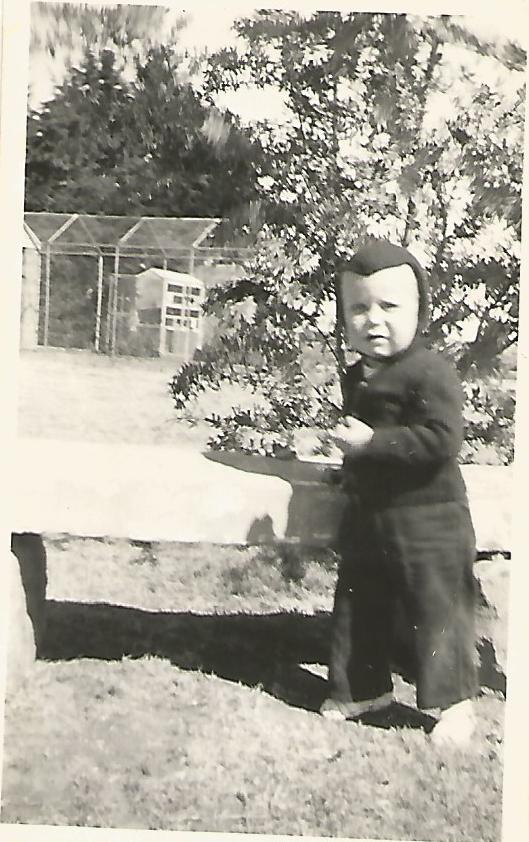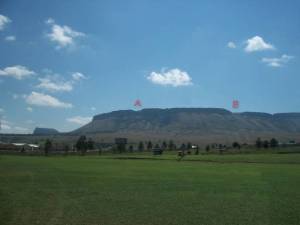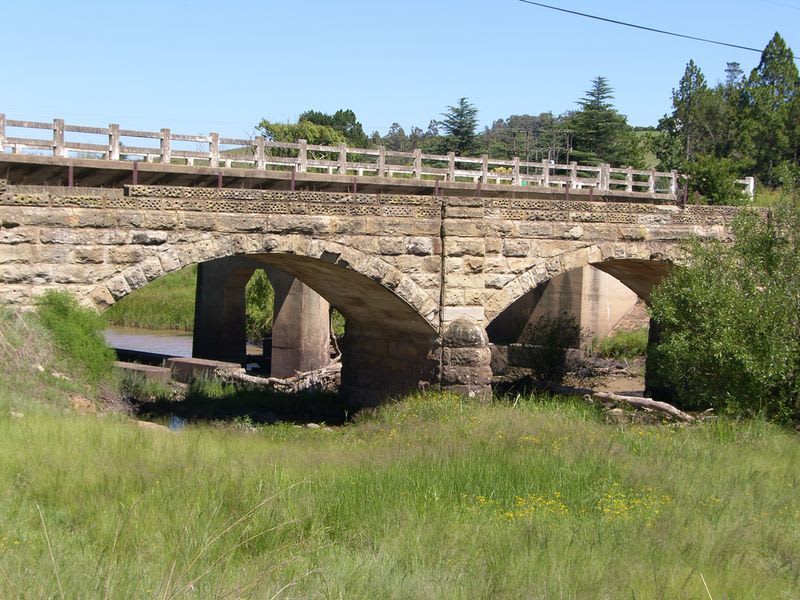A re-post cos Mom told me some news today (see right at the end):
My first recollections are of life on the plot outside Harrismith, playing with Enoch and Casaia, childhood companions, kids of Lena and Bennett Mazibuko, who looked after us as Mom and Dad worked in town. The plot was in the shadow of Platberg, and was called Birdhaven, as Dad kept big aviaries. I remember Lena as kind and loving – and strict!
I lived there from when I was carried home from the maternity home till when I was about five years old, when we moved into town.

I remember suddenly “knowing” it was lunchtime and looking up at the dirt road above the farmyard that led to town. Sure enough, right about then a cloud of dust would appear and Mom and Dad would arrive for their lunch and siesta, having locked up the Platberg bottle store at 1pm sharp. I could see them coming along the road and then sweeping down the long driveway to park near the rondavel at the back near the kitchen door. They would eat lunch, have a short lie-down and leave in time to re-open at 2pm. I now know the trip was exactly 3km door-to-door, thanks to google maps.
Every day I “just knew” they were coming. I wonder if I actually heard their approach and then “knew”? Or was it an inner clock? Back then they would buzz around in Mom’s Ford Prefect or Dad’s beige Morris Isis. Here’s an old 8mm movie of the old green and black Ford Prefect on the Birdhaven circular driveway – four seconds of action – (most likely older sister Barbara waving out the window):

1. Ruins of our house; 2. Dougie Wright, Gould & Ruth Dominy’s place; 3. Jack Levick’s house; 4. The meandering Kak Spruit. None of those houses on the left were there back then.
Our nearest neighbour was Jack Levick and he had a pet crow that mimic’d a few words. We had a white Sulphur-crested Cockatoo Jacko that didn’t, and an African Grey parrot Cocky who could mimic a bit more. Helmeted Guineafowl would visit by day, and a tame-ish Spotted Eagle Owl would visit at night.
Our next neighbours, nearer to the mountain, were Ruth and Gould Dominy and Ruth’s son Dougie Wright on Glen Khyber. They were about 500m further down the road towards the mountain, across the Kak Spruit over a little bridge. Doug’s cottage was on the left next to the spruit that came down from Khyber Pass and flowed into the bigger spruit; The big house with its sunny glassed-in stoep was a bit further on the right. Ruth and a flock of small dogs would serve Gould his tea in a teacup the size of a big deep soup bowl. I wonder how many sugars he added?

Judas Thabete lived on the property and looked after the garden. I remember him as old, small and bearded. He lived in a hovel of a hut across a donga and a small ploughed field to the west of our house. He had some sort of cart – animal-drawn? self-drawn? Self-drawn, I think.

Other things I remember are driving out and seeing white storks in the dead bluegum trees outside the gate – those and the eagle owl being the first wild birds I ‘spotted’ in my still-ongoing birding life; The storks brought babies we were told – can’t level with kids. Hope parents are more straight-up with their kids these days. I remember the snake outside the kitchen door;

I don’t remember but have been told, that my mate Donald Coleman, two years older, would walk the kilometre from his home on the edge of town to Birdhaven to visit me. Apparently his Mom Jean would phone my Mom Mary on the party line and ask, “Do you have a little person out there?” if she couldn’t find him. He was a discoverer and a wanderer and a thinker, my mate Donald.

Bruno the doberman came from Little Switzerland on Oliviershoek pass down the Drakensberg into Natal. Leo and Heather Hilcovitz owned and ran it – “very well” according to Dad. Leo came into town once with a few pups in the back of his bakkie. Dobermans. Dad said I Want One! and gave Leo a pocket of potatoes in exchange for our Bruno. He lived to good age and died at 95 Stuart Street after we’d moved to town.

~~~oo0oo~~~
rondavel – circular building with a conical roof, often thatched;
spruit – stream; kak spruit: shit stream; maybe it was used as a sewer downstream in town in earlier days?
stoep – veranda
donga – dry, eroded watercourse; gulch, arroyo; scene of much play in our youth;
bakkie – pickup truck
~~~oo0oo~~~

A newsflash the year I was born – check the cars.
Our Ford Prefect was somewhere between a 1938 and a 1948 – the ‘sit up and beg’ look, before sedans went flat. They were powered by a 4 cylinder engine displacing 1172cc, producing 30 hp. The engine had no water pump or oil filter. Drive was through a 3-speed gearbox, synchromesh in 2nd and 3rd. Top speed nearly 60mph. Maybe with a bit of Downhill Assist?
~~oo0oo~~
Today – 25 Sept 2021 – Mom (who turned 93 a week ago today) tells me Kathy Schoeman bought the old Ford Prefect from her and one day they drove to work to see it lying on its roof in the main street outside the town hall! Kathy had rolled it in the most prominent place possible!















































